Audiovisual essays 2023
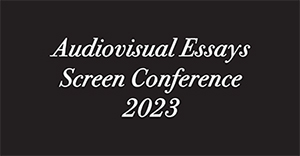 This year, the theme of the Screen conference was ‘Screen Worlds’. This selection of audiovisual essays was chosen by four curators with that theme in mind.
This year, the theme of the Screen conference was ‘Screen Worlds’. This selection of audiovisual essays was chosen by four curators with that theme in mind.
The curators talk about their selection process in this video and the essays are available to view below.
Delegates at the Screen Studies Conference 2023 voted on the essays, and chose as the winner Katie Bird.
Distant Journey Through the Desktop (Jiří Anger and Jiří Zak, 2020)
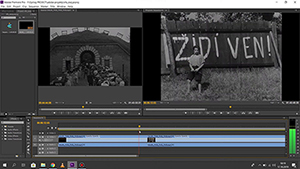 Jiří Anger and Jiří Žák’s ‘Distant Journey Through the Desktop’ focuses on a type of screen world building that is unusual in the fiction film, but routine within videographic criticism: the use of multiple screens. Their video essay provides illuminating commentary on the deployment of picture-in-picture compositions and the combination of documentary and fiction footage in its ostensible object of study: the 1948 Czech Holocaust film, ‘Distant Journey/Daleká cesta’. At the same time, it does so through a performative presentation of the desktop interface, where multiple screens habitually vie for our attention. Anger and Žák succeed in connecting the interplay between screens in ‘Distant Journey’ with a contemporary desktop-based viewing and thinking process, whilst still offering important critical insights into the film itself. (Chosen by Ian Garwood)
Jiří Anger and Jiří Žák’s ‘Distant Journey Through the Desktop’ focuses on a type of screen world building that is unusual in the fiction film, but routine within videographic criticism: the use of multiple screens. Their video essay provides illuminating commentary on the deployment of picture-in-picture compositions and the combination of documentary and fiction footage in its ostensible object of study: the 1948 Czech Holocaust film, ‘Distant Journey/Daleká cesta’. At the same time, it does so through a performative presentation of the desktop interface, where multiple screens habitually vie for our attention. Anger and Žák succeed in connecting the interplay between screens in ‘Distant Journey’ with a contemporary desktop-based viewing and thinking process, whilst still offering important critical insights into the film itself. (Chosen by Ian Garwood)
This video was published in [in]Transition with an accompanying creators’ statement and written peer reviews.
Feeling and Thought as They Take Form: Early Steadicam, Labor, and Technology (1974-1985) (Katie Bird, 2020)
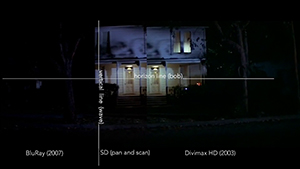 Like ‘Distant Journey Through the Desktop’, Katie Bird’s Feeling and Thought as They Take Form works both as a fascinating investigation of its ostensible object of study as well as an exploration of the possibilities of videographic criticism. Indeed, its title evokes the understanding of videographic criticism as a form that makes meaning experientially, as much as it refers to the embodied practices of Steadicam/Panaglide cinematography that the video essay explores on its surface. Additionally, the video pays attention to the labour involved in creating screen worlds. Predominantly, it focuses on the labour of early Steadicam/Panaglide camera operators, but also hints, through Bird’s careful explanation of her research and experimental processes, at the labour underlying videographic criticism. (Chosen by Ian Garwood)
Like ‘Distant Journey Through the Desktop’, Katie Bird’s Feeling and Thought as They Take Form works both as a fascinating investigation of its ostensible object of study as well as an exploration of the possibilities of videographic criticism. Indeed, its title evokes the understanding of videographic criticism as a form that makes meaning experientially, as much as it refers to the embodied practices of Steadicam/Panaglide cinematography that the video essay explores on its surface. Additionally, the video pays attention to the labour involved in creating screen worlds. Predominantly, it focuses on the labour of early Steadicam/Panaglide camera operators, but also hints, through Bird’s careful explanation of her research and experimental processes, at the labour underlying videographic criticism. (Chosen by Ian Garwood)
This video was published in [in]Transition with an accompanying creator’s statement and written peer reviews.
Wild at Heterosexuality (Dayna McLeod, 2022)
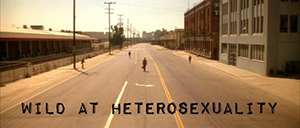 ‘When you’re a het, you’re a het!’ With this burst of sung voiceover, Dayna McLeod achieves an enticing combination of tongue-in-cheek playfulness, wry critique and queer frustration. ‘Wild at Heterosexuality’ is an excellent example of how voiceover can be used expressively in videographic criticism. It is used to describe the film’s world as McLeod sees it, wrestling with its queer potentiality in the face of so much homophobia, and thus plays in dynamic tension with the image. An attempt to bend the film to expose a possible homoerotic subtext is undercut by McLeod’s weary ‘But this is just an editing trick. Queers do not exist here’. Such audiovisual strategies use contrast and tone to illuminate the expressive ways videographic criticism can work simultaneously with and against a text. McLeod’s choices also bring together a range of influences and practices - vidding, queer theory, performance art – which have informed the development of the video essay more generally. All in all, for me this work dramatises a critical world-building that is as rich and engaging as it is dynamic and concise. (Chosen by Lucy Fife Donaldson)
‘When you’re a het, you’re a het!’ With this burst of sung voiceover, Dayna McLeod achieves an enticing combination of tongue-in-cheek playfulness, wry critique and queer frustration. ‘Wild at Heterosexuality’ is an excellent example of how voiceover can be used expressively in videographic criticism. It is used to describe the film’s world as McLeod sees it, wrestling with its queer potentiality in the face of so much homophobia, and thus plays in dynamic tension with the image. An attempt to bend the film to expose a possible homoerotic subtext is undercut by McLeod’s weary ‘But this is just an editing trick. Queers do not exist here’. Such audiovisual strategies use contrast and tone to illuminate the expressive ways videographic criticism can work simultaneously with and against a text. McLeod’s choices also bring together a range of influences and practices - vidding, queer theory, performance art – which have informed the development of the video essay more generally. All in all, for me this work dramatises a critical world-building that is as rich and engaging as it is dynamic and concise. (Chosen by Lucy Fife Donaldson)
shiplap (Eva Hageman, 2021)
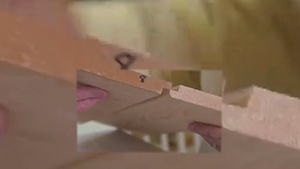 I nominated ‘shiplap’ for the ways in which Eva Hageman uses the videographic form to expand screen worlds through an intricate layering of voice (diegetic and non-diegetic), environmental sound, music, text and image. Hageman’s audiovisual essay extends our understanding of a specific screen world – that of a reality television show, Fixer Upper – through engagement with the histories of a particular material (the titular shiplap). Hageman gradually redraws the frame of that world through a process of audiovisual accumulation, led by repetitions of references to shiplap and its uses, which build outwards through collages of television programming, ethnographic footage, historical images and advertising materials, in order to spatialise, historicise and ultimately racialise it. A particularly striking moment is Hageman’s whispered voiceover which bridges historical moments of racial violence (the black Atlantic slave trade and the story of a lynching in Waco) that underpin the critical world-building being enacted. The whisper introduces the speculative connections being set-up between shiplap as a material and these violent histories, a rhetorical move which might make us lean in at the critical moment when the argument shifts, providing a moment of intimacy that makes us keenly aware of the maker and her position. (Chosen by Lucy Fife Donaldson)
I nominated ‘shiplap’ for the ways in which Eva Hageman uses the videographic form to expand screen worlds through an intricate layering of voice (diegetic and non-diegetic), environmental sound, music, text and image. Hageman’s audiovisual essay extends our understanding of a specific screen world – that of a reality television show, Fixer Upper – through engagement with the histories of a particular material (the titular shiplap). Hageman gradually redraws the frame of that world through a process of audiovisual accumulation, led by repetitions of references to shiplap and its uses, which build outwards through collages of television programming, ethnographic footage, historical images and advertising materials, in order to spatialise, historicise and ultimately racialise it. A particularly striking moment is Hageman’s whispered voiceover which bridges historical moments of racial violence (the black Atlantic slave trade and the story of a lynching in Waco) that underpin the critical world-building being enacted. The whisper introduces the speculative connections being set-up between shiplap as a material and these violent histories, a rhetorical move which might make us lean in at the critical moment when the argument shifts, providing a moment of intimacy that makes us keenly aware of the maker and her position. (Chosen by Lucy Fife Donaldson)
This video was published in [in]Transition with an accompanying creator’s statement and written peer reviews.
Nazarbazi (Maryam Tafakory, 2022)
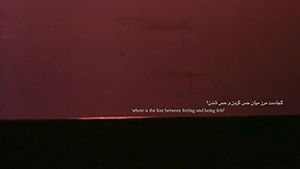 Maryam Tafakory’s short film ‘Nazarbazi’ presents an assemblage of gazes from dozens of Iranian films produced in the Islamic Republic since 1979, a period in which depictions of touching between the sexes has been forbidden. The absence of touch draws attention to other forms of interaction: the proximity of bodies, characters' gazes, and the passing of objects. The film is accompanied by epigraphic texts in Farsi and English intermixed with original texts by Tafakory. The poetic mélange of texts provokes questions and possibilities for how it could be applied to academic scholarship. ‘Nazarbazi’ thus becomes a site for a play between videographic scholarship and video art, exploring the ways in which they may share the same gaze. Its theme of distanced touching through seeing also resonates with its time of production during the pandemic, when the dictum of no touching applied not only to Iranian filmmaking but to everyday living worldwide. The film also encompasses all the time spent by Tafakory in re-watching dozens of Iranian films and re-editing them into a singular expression on the poetics and politics of prohibition and access. It addresses a policy of cinematic censorship with resourceful euphemism, and honors the resilient spirit of expression that arises in the face of such circumstances. (Chosen by Kevin B. Lee)
Maryam Tafakory’s short film ‘Nazarbazi’ presents an assemblage of gazes from dozens of Iranian films produced in the Islamic Republic since 1979, a period in which depictions of touching between the sexes has been forbidden. The absence of touch draws attention to other forms of interaction: the proximity of bodies, characters' gazes, and the passing of objects. The film is accompanied by epigraphic texts in Farsi and English intermixed with original texts by Tafakory. The poetic mélange of texts provokes questions and possibilities for how it could be applied to academic scholarship. ‘Nazarbazi’ thus becomes a site for a play between videographic scholarship and video art, exploring the ways in which they may share the same gaze. Its theme of distanced touching through seeing also resonates with its time of production during the pandemic, when the dictum of no touching applied not only to Iranian filmmaking but to everyday living worldwide. The film also encompasses all the time spent by Tafakory in re-watching dozens of Iranian films and re-editing them into a singular expression on the poetics and politics of prohibition and access. It addresses a policy of cinematic censorship with resourceful euphemism, and honors the resilient spirit of expression that arises in the face of such circumstances. (Chosen by Kevin B. Lee)
Please note this video is password-protected. Screen delegates received the password in an e-mail sent on 19th June, 2023. Please do not disseminate the password further.
The Rise of Film TikTok (Queline Meadows, 2020)
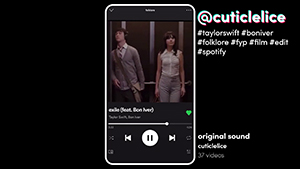 Published in 2020, ‘The Rise of Film TikTok’ by Queline Meadows, known as kikikrazed on YouTube, remains among the most informed and engaging explorations of how TikTok has yielded distinct forms of film criticism and cinephile culture. Made at a moment when TikTok began to yield content that could be described as video essays, Meadows’ video analyzes a variety of videographic expressions found on the platform, such as recommendation videos, supercuts, and edits, while identifying distinct nuances in their respective utilizations of text, editing and music to convey critical meaning within the app’s highly compressed ADHD interface. Meadows pursues a daunting task of accounting for a media environment that, due to the role of algorithms in customizing a user’s content feed and the speed by which trends and forms on the platform evolve, is highly dynamic and ephemeral. Indeed, Meadows’ opening disclaimer, “some of the references in this video won’t make sense in a month” proved true, as today’s Film TikTok feed yields a completely different set of forms and practices. In this light, Meadows’ video becomes a precious work of media archaeology, a time capsule capturing the moment when a new platform gave birth to new practices of the video essay. (Chosen by Kevin B. Lee)
Published in 2020, ‘The Rise of Film TikTok’ by Queline Meadows, known as kikikrazed on YouTube, remains among the most informed and engaging explorations of how TikTok has yielded distinct forms of film criticism and cinephile culture. Made at a moment when TikTok began to yield content that could be described as video essays, Meadows’ video analyzes a variety of videographic expressions found on the platform, such as recommendation videos, supercuts, and edits, while identifying distinct nuances in their respective utilizations of text, editing and music to convey critical meaning within the app’s highly compressed ADHD interface. Meadows pursues a daunting task of accounting for a media environment that, due to the role of algorithms in customizing a user’s content feed and the speed by which trends and forms on the platform evolve, is highly dynamic and ephemeral. Indeed, Meadows’ opening disclaimer, “some of the references in this video won’t make sense in a month” proved true, as today’s Film TikTok feed yields a completely different set of forms and practices. In this light, Meadows’ video becomes a precious work of media archaeology, a time capsule capturing the moment when a new platform gave birth to new practices of the video essay. (Chosen by Kevin B. Lee)
Terror Nullius Unmixed (Caitlin Lynch, 2020)
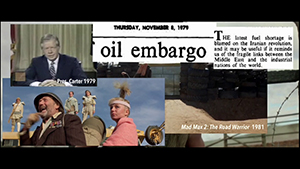 The strength of ‘Terror Nulllius Unmixed’ resides in Lynch’s willingness to wrestle with the questions of recognition and familiarity in remixes. I would suggest that these same issues are important to videographic essays. Lynch points out that film remixes depend on recognition for them to be understood by audiences. However, there is no guarantee that any given audience will immediately get the references. Lynch therefore employs techniques that are frequently used in videographic essays - multiscreen, text on screen, desktop documentary stylistics - in ways that hammer home the progressive messages of the remix ‘Terror Nullius’. For me, Lynch’s unmixing offers insights for videographic essayists. At times videographic essay work can be as reliant on recognition and familiarity as the remix. To put that differently, videographic essays, frequently, rely on their audience to inhabit the same archival landscape that the films they are critiquing inhabit. And some videographic essayists eschew visual, audio, textual signs that anchor the videographic text to arguments that intervene in problematic world building. While the desire for open experimentation is laudable and vitally important for some videographic work, in some instances it leaves the world created in many mainstream films and film archives intact. And when those films and film archives rely on problematic representations, absences, labor practices, or distributions of wealth go uninterrogated. (Chosen by Susan Harewood)
The strength of ‘Terror Nulllius Unmixed’ resides in Lynch’s willingness to wrestle with the questions of recognition and familiarity in remixes. I would suggest that these same issues are important to videographic essays. Lynch points out that film remixes depend on recognition for them to be understood by audiences. However, there is no guarantee that any given audience will immediately get the references. Lynch therefore employs techniques that are frequently used in videographic essays - multiscreen, text on screen, desktop documentary stylistics - in ways that hammer home the progressive messages of the remix ‘Terror Nullius’. For me, Lynch’s unmixing offers insights for videographic essayists. At times videographic essay work can be as reliant on recognition and familiarity as the remix. To put that differently, videographic essays, frequently, rely on their audience to inhabit the same archival landscape that the films they are critiquing inhabit. And some videographic essayists eschew visual, audio, textual signs that anchor the videographic text to arguments that intervene in problematic world building. While the desire for open experimentation is laudable and vitally important for some videographic work, in some instances it leaves the world created in many mainstream films and film archives intact. And when those films and film archives rely on problematic representations, absences, labor practices, or distributions of wealth go uninterrogated. (Chosen by Susan Harewood)
This video was published in [in]Transition with an accompanying creator’s statement and written peer reviews.
Cracks in the Czech Film Heritage (Jan Kinzl and Max Stejskal, 2022)
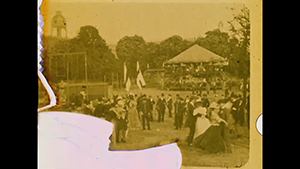 In my response to ‘Terror Nulllius Unmixed’ I argued for explicit intervention into the worldmaking/world affirming of the videographic essay. However, I make what might seem like something of a 180 degree turn with my response to ‘Cracks in the Czech Film Heritage’. This video essay offers a somewhat open approach to the meaning making of national film archives. ‘Cracks in the Czech Film Heritage’ invites contemplation of the work that film, archives, and technology play in constructing the national imagination and how images from the past can, or indeed, cannot, be drafted into constructing a national present. Kinzl and Stejskal’s video essay is a deformation that reexamines Jan Kříženecký’s film, ‘Midsummer Pilgrimage in a Czechoslavic Village’ (1898). Kinzl and Stejskal note that the digitization of film holdings of the Czech National Film Archive (NFA) makes archival films available for creative play. The NFA made two versions of Kříženecký’s film available – a yellowed original copy that shows the cracks and scratches on the film strip, and a black and white original negative that is free from most of those cracks and scratches. Kinzl and Stejskal’s video essay introduces scratches from the original copy of the film into the more pristine version of the film from the original negative. Cracks draws attention to how increased digital availability and domestication of archival material might give the impression that we have easy access to the past. However, their technique of using the cracks and scratches opens up the text again to consider the erasures/losses/distorted presences/absences that exist in any archive. (Chosen by Susan Harewood)
In my response to ‘Terror Nulllius Unmixed’ I argued for explicit intervention into the worldmaking/world affirming of the videographic essay. However, I make what might seem like something of a 180 degree turn with my response to ‘Cracks in the Czech Film Heritage’. This video essay offers a somewhat open approach to the meaning making of national film archives. ‘Cracks in the Czech Film Heritage’ invites contemplation of the work that film, archives, and technology play in constructing the national imagination and how images from the past can, or indeed, cannot, be drafted into constructing a national present. Kinzl and Stejskal’s video essay is a deformation that reexamines Jan Kříženecký’s film, ‘Midsummer Pilgrimage in a Czechoslavic Village’ (1898). Kinzl and Stejskal note that the digitization of film holdings of the Czech National Film Archive (NFA) makes archival films available for creative play. The NFA made two versions of Kříženecký’s film available – a yellowed original copy that shows the cracks and scratches on the film strip, and a black and white original negative that is free from most of those cracks and scratches. Kinzl and Stejskal’s video essay introduces scratches from the original copy of the film into the more pristine version of the film from the original negative. Cracks draws attention to how increased digital availability and domestication of archival material might give the impression that we have easy access to the past. However, their technique of using the cracks and scratches opens up the text again to consider the erasures/losses/distorted presences/absences that exist in any archive. (Chosen by Susan Harewood)
This video was published with a written statement in the online edition of the Czech film journal, Film A Doba.

